For some time now, the “Philosophy” section of my bio has said this:
“Bit by bit, putting it together…” – Stephen Sondheim
Putting a show together is often like a big jigsaw puzzle. Unlike recreational puzzles, productions don’t usually have a “picture on the front of the box” to help guide you, and you may not even be sure if you have all the puzzle pieces. However, you can use what you’ve learned from other production puzzles to go about creating the best version of the current project possible, and figuring out how to fill in what might be missing. If you have a team of people working on the puzzle, focusing on their areas, but adding to the overall picture, you can create a great work of art.
….And it’s fun to vary between large complex puzzles and ones with fewer pieces!
—
Well, on my latest show, we have a lot of time together, including warmups starting up to three hours before curtain, and are ready to open the house at an hour before (which usually turns into more like 40 minutes before our audiences start to arrive). We created a venue out of a convention center exhibit hall, so we don’t have a years-old greenroom filled with shelves full of things to pass the time. I decided to bring in a tradition from other places I’ve worked, and brought in a puzzle. It took a little bit for people to get going, but now we’re going gangbusters. We’re currently on puzzle #4, our first 1000-piece puzzle.
Puzzle #1 was one I travel with as it is so compact – but I had never actually put it together.
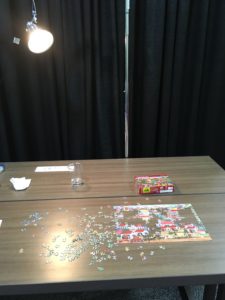
Puzzle #2 was a gag gift from my mother: a factory-fresh bag of puzzle pieces, but just like my theatre description, it HAD NO PICTURE! This is when the fun really began with my cast. It didn’t matter what their language (we had people with primary languages of Amharic and Russian in addition to English working on that one), but everyone was fascinated with what it would be. We finished that one in I think one full night. It was around 300 pieces.
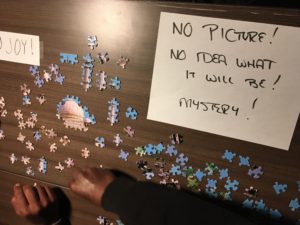
It’s also interesting to see how people go about puzzles. In my experience, edge pieces are almost always pulled out first, so you get a framework and you know the scale of the piece. Same with theatre. Then, everyone starts focusing on something different. Some people love to tackle the blue sky or water. I am not one of those people. Give me things that I can look at the box, and then go “oh, that’s this thing,” and fit it in. On the unknown picture one, I started pulling out all of the pieces that looked like a building…and I was the first to figure out we were creating the Taj Mahal. It doesn’t matter if we don’t quite all speak the same language, we’re working towards the same goal – a finished puzzle. If someone is working on the brickwork, we hand them over the pieces that look like their part. Occasionally, someone joggles the table – which for us is actually two skinny tables next to each other, and some pieces fall apart. So we patch them back together, and check to see what fell on the floor. That first puzzle was in fact missing a piece. One of the wardrobe women MADE us a new piece, out of paper and ink, and at a glance you’d never know it wasn’t original!
This is theatre. And it’s an awesome collaborative process.
You also can’t keep the finished puzzle together for very long. I mean, some people shellac and frame them, but really, is that ever as good as having worked on the puzzle? At some point, it’s best to pack it back into the box, and look forward to doing it another time. (Or say, “That’s one I don’t care to work on again!”) Likely, you’ll never create it again with the same group of people, but that’s also part of the process.
That said, I wonder how many more puzzles we’ll put together? We have 26 shows left!
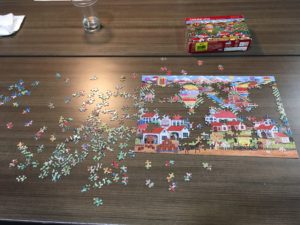
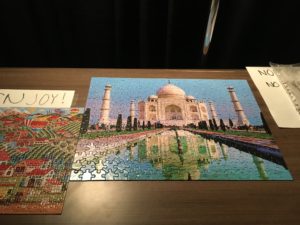
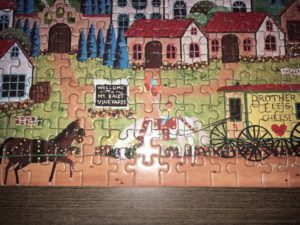
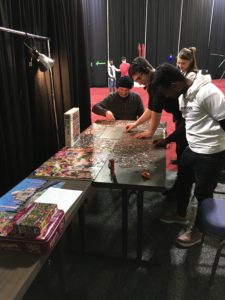
Thank you for this.
If I could click a button and have this piece instantly replace all the myriad online posts agonising about resume formats, GIFs of stage managerial exasperation, what to carry in an SM’s kit, or sales on post-it flags and pens, I would. Sometimes I think we confuse the tools with the task – this piece describes both beautifully.
Thank you so much for your comment, Allan. I’m all about many of the tools too, but yeah, I like discussing the tasks too. This philosophy really seems to fit me, and I loved when I could see it “live” recently, even down to creating pieces that weren’t there.
Love this! Thank you-
Dani